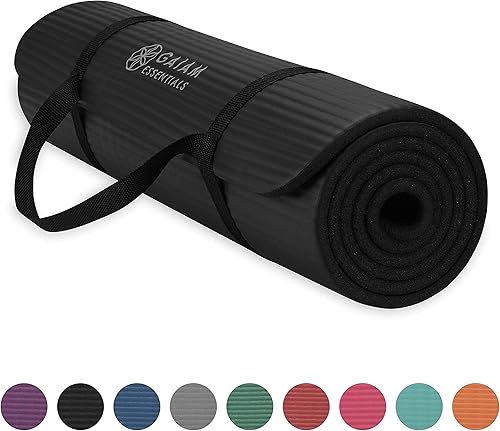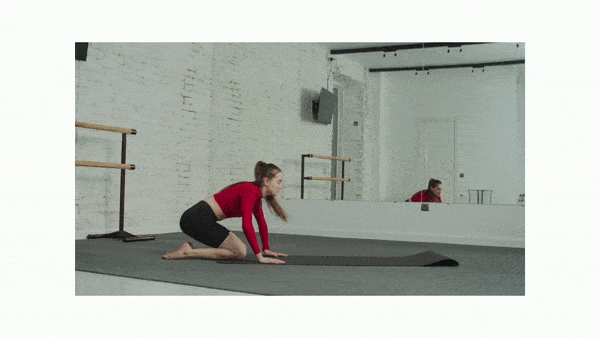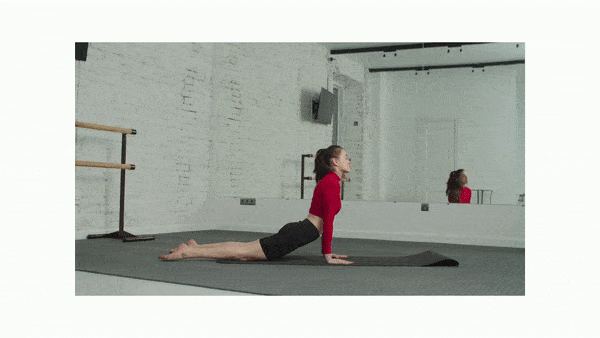When you want to kickstart a new fitness routine, yoga is a great place to begin.
Yoga stretches out those muscles (along with the joints, tendons, and ligaments) that have been lying dormant and can help prevent injury in faster-paced sports and activities.
This, by no means, implies yoga is easy.
Many of the stretches in yoga require at least some strength and flexibility.
But yoga is an easy activity to start slowly and build upon.
Over time, you will start to develop your muscles and become a more flexible person over all.
If you can stick with it and dedicate to the practice.
This page contains some affiliate links. If you click through and make a purchase, I’ll earn a commission, at no additional cost to you. Read my full disclosure here.
What Is Yoga?
Yoga is a meditative discipline from India that combines spiritualism with breath and movement.
It has been around for at least 5,000 years
The term itself comes from the Sanskrit “Yuj,” which means “to join” or “to unite,” which is what yoga aims to do – combine body and mind to improve both physical and mental wellbeing.
Benefits of Yoga
Many studies have shown the extraordinary benefits of yoga for those who develop (and stick to) a routine.
Some documented benefits of yoga include:
- Improved strength
- Improved flexibility
- Improved balance
- Improved heart health (including lower blood pressure)
- Improved respiratory rates
- Improved sleep
- Weight loss
- Reduced inflammation
- Pain relief, especially muscle and joint paint, which means yoga helps with the following conditions:
- Arthritis
- Chronic back pain
- Menstrual pain
- Menopause
- Nerve stimulation, especially the vagus nerve, which can help:
- Reduce stress
- Reduce anxiety
- Reduce depression
- Improve overall mental health
- Increase alertness
- Decrease the frequency and strength of migraines
Is Yoga Hard?
Yoga consists of many diverse movements that range in intensity and difficulty.
Some of the moves are very simple.
Others require an incredible amount of strength and flexibility and take years to perfect.
When you first start to practice yoga, you might find a lot of things you think should be easy will feel surprisingly difficult.
This is because yoga bends and moves your body in ways that you are unlikely to use them in day-to-day life.
The less flexible you are when you begin, the harder it will feel.
But, hang in there. It does get easier, you will get more flexible, and, as your flexibility begins to improve, every move in yoga feels better and better.
Which Yoga Is Best For Beginners?
Hatha yoga is yoga in its most basic form. It consists of getting into yoga poses (or asanas), holding them, and breathing.
It is best for beginners because it gives you time to get familiar with the proper form of each pose.
Iyengar yoga is another good form of yoga for beginners, especially beginners who are trying to recover from an injury or worry they won’t have the strength or flexibility to hold yoga poses properly.
Iyengar incorporates equipment into poses to ensure proper form, making it ideal for people who need a little extra support.
How Often Should You Do Yoga?
The most basic poses of yoga are easy on the body, but still work the muscles.
As a beginner, you can start with two to three sessions per week.
More than that, and you won’t allow your muscles proper time to heal.
Less than that, and you will lose progress with your flexibility.
Can I Do Yoga Every Day?
No. Not at first.
Eventually, many people who practice yoga develop the strength and flexibility to do yoga every day without any harm to their bodies.
But, when you first start yoga, it’s like any other exercise.
It will stretch tendons and joints and put tears in your muscles.
Two to three times a week is plenty, with a day of rest in between.
What Is The Best Time To Do Yoga?
While you can do yoga at any time of day, most yogis recommend sessions either first thing in the morning or in the early evening, and it’s not just because the sun is nice at those times.
Since yoga is a spiritual practice as much a physical one, a morning session helps set your tone for the day.
Likewise, an early evening session provides a solid separation between the workday and your personal time.
Just don’t do your session too close to bed. It can interfere with sleep just like any exercise.
Can A Beginner Learn Yoga At Home?
With information about the postures (asanas), anyone can learn yoga at home.
That said, yoga is more complex than some of the poses make it look, so it’s essential to make sure you are doing it safely.
If you are going to learn yoga on your own, take care to learn the proper form of each pose and pay close attention to your body.
For our recommendations, check out our guide: Yoga Videos: 5 Best Yoga For Beginners On YouTube (For Seniors, Men, Women & Everyone Getting Started).
Is Yoga A Good Workout?
You won’t work up much of a sweat doing it at its most basic level, but, yes, yoga is a good workout.
It’s basically stretching and strength training, so your muscles and joints will get stronger with yoga.
Can You Lose Weight With Yoga?
Yoga isn’t an aerobic exercise. You won’t burn as many calories with most forms of yoga as you would by going for a run or a bike ride.
However, yoga does build muscle, which burns more calories than fat.
There are also advanced forms of yoga that incorporate flow between asanas, which basically means you are moving from one posture fluidly into another, or increase the pace.
When you are going through yoga poses more quickly (but safely, of course) with flow in between, you will burn more calories than just doing the poses alone.
Yoga will absolutely change the structure of your body.
Whether or not you’ll lose weight depends on how much and the type of yoga you do.
Is Yoga Enough Exercise?
While some versions of yoga raise the heart rate more than others, yoga is not considered a cardio/aerobic exercise.
With the right combination of poses, yoga could serve as your sole strength training regimen. But to ensure heart health, it’s important to get some extra additional cardio.
How Long Does It Take For Yoga To Work?
It depends what we mean by “work”?
If we mean “lose weight,” the answer is it may never work.
Yoga is simply not that type of exercise.
If we mean “see improvements in physical and mental health,” the answer is a few weeks.
(A study on patients with heart failure showed yoga improved heart health within eight weeks.
A study on patients with depression showed yoga improved mental health in the same amount of time.)
If we mean “notice changes in our bodies,” the answer is far more encouraging.
Within a week or two (3-5 sessions) you will notice a few minor things while doing yoga.
Poses will get easier to hold. Stretches will take less effort.
You may even notice the changes in the poses themselves. (I find it particularly noticeable in downward-facing dog, where your feet slowly but surely inch closer to being flat on the floor.)
How Many Minutes A Day Should A Beginner Do Yoga?
Many practitioners recommend yoga beginners start with an hour of yoga per session, and this is physically doable for most people doing the gentlest poses.
It’s also a big block of time if you’re busy.
It’s important to remember, any yoga you do will improve your strength and flexibility.
Studies have shown that doing as little as 10 minutes of yoga per day can have beneficial effects.
Can Yoga Make You Sore?
Heh. Yeah.
Yes, yoga really does make you sore.
How To Learn Yoga
When you’re ready to start with yoga, you have a few different options:
You can learn on your own (as long as you’re careful with form and pay attention to your body).
You can learn through private lessons.
You can learn in a class or at a retreat.
Which one of these methods is right for you depends on your personality, exercise style, and comfort level.
Home Yoga
If you prefer not to do your exercising in a group of strangers (hand going up here), you might prefer to learn yoga on your own or with a private instructor.
You don’t need a lot of (or any) equipment to get started, and you’ll find plenty of free yoga videos on YouTube.
Yoga Equipment for Beginners
One thing that makes yoga such a good place to start an exercise regimen is that you don’t need any equipment to get started.
You can do yoga poses right now on any solid surface.
The one thing you might want up front, however, is a mat.
A mat makes yoga poses considerably more comfortable, especially on hard floors.
Yoga mats come in different thicknesses, which have different things going for them.
Thicker mats have more padding, which can provide greater protection to your knees, elbows, and other jutty parts while doing certain poses.
Thinner mats have less give, which makes it easier to balance once you get into more complicated poses.

It’s up to you which type of mat you prefer, but if you worry about discomfort, you should consider starting with a thicker mat and moving to a thinner one as you advance.
Here are a couple of mats we like:
- Hugger Mugger (thinner)
- Gaiam Essentials Thick Yoga Mat (thicker)
Best Yoga Poses for Beginners
Once you have your mat (or a comfy bit of floor), you can get started in yoga with only a few simple poses.
These are our five favorite starting poses for beginners.
Yoga Beginner Pose 1: Child Pose
Why we like it for beginners: Child pose is about as comfortable as you can get in yoga while still being in asana.
It’s a good resting pose to come back to when you get tired or feel too tightly stretched, so it’s best to learn it first.
Yoga Beginner Pose 2: Cobra Pose
Why we like it for beginners: Cobra pose is a simple stretch that actually feels simple.
It requires only bracing yourself off the floor while (gently) stretching back, but engages a lot of the muscles you’ll need to start stretching and strengthening to progress in your yoga practice, including your back, abs, arms, wrists, and shoulders.
Yoga Beginner Pose 3: Chair Pose
Why we like it for beginners: Chair pose is a strength-building pose that focuses on your legs, helping build power you’ll need for more complex standing poses.
It’s also based in a familiar movement – sitting down – so is one of the easier poses for most beginners to get right when it comes to form.
Yoga Beginner Pose 4: Downward-Facing Dog
Why we like it for beginners: Downward-facing dog is one of the easiest inversion asanas for beginners.
It stretches and tones both the arms and legs, especially the shoulders and calves.
It’s also an excellent determiner of your level of flexibility when you first start yoga.
As you’re trying to get into a perfect downward dog, you’ll know exactly how flexible you are (or aren’t).
Yoga Beginner Pose 5: Bridge
Why we like it for beginners: Bridge pose is a little more involved than these other poses, and will take a little more effort to get into properly for most beginners.
But it still isn’t difficult and will help you really focus on form.
It’s also one of the best yoga postures for lower back pain and will give you a feel for exactly how yoga can relieve body stress you might not even know you have.
Learning Yoga With A Private Instructor
If you still prefer not to do your exercising in a group, but feel like you could use a little instruction, you can get it with a private yoga lesson.
A private lesson is exactly like a class, except it’s just you and the instructor. (Or you and whoever else you want to include and the instructor.)
The disadvantage of a private lesson is that it’s considerably more expensive than a yoga class. (Some private yoga instructors charge over $100/hour.)
The advantage of a private yoga lesson is that the instructor will be focused solely on you.
So, if you really want to nail form, it can be beneficial.
Yoga Classes For Beginners
If you’re a social butterfly, or need the motivation of a group to stay on track, you might prefer to learn your yoga in a class.
It doesn’t necessarily have to be through a yoga studio.
Many gyms and YMCAs have beginner yoga classes for members.
Gyms that offer yoga also typically have mats available to borrow, but, if you’re going the class route, you’ll probably want your own mat.
There’s no guarantee you’ll get one when you get there, or that it will be the kind (or as clean as) you want.
What To Wear For Yoga
When dressing for a yoga class (or even to do yoga at home), think balance.
Don’t wear anything too tight, which will constrict your movement, or too loose, which will get in the way of your movement.
You’ll also want to make sure whatever you wear will stay put. Some poses, like downward dog, have you facing downward.
A loose shirt can easily fall and expose your whole business.
There’s a reason yoga pants are yoga pants.
Soft, comfortable clothing that is well-fitted to your body is ideal.
Yoga Retreats For Beginners
While you can easily learn yoga at home or in a class, if you want to truly immerse yourself in the discipline, a yoga retreat can be a great idea for beginners.
At a retreat, not only will you get solid instruction and guidance, but you will be able to settle into your yoga routine, making it easy to continue on your own or start classes once you get back home.
It’s also a great way to really explore the spiritual side of yoga.
Yoga retreats last differing amounts of time and take place all over the world, like this 14-day yoga retreat in India or this 21-day retreat in Nepal.
You can also find one-off classes that incorporate yoga into a broader experience, like this half-day yoga and Buddhism retreat in Nepal or this nighttime stand-up paddleboard yoga session in Honolulu.
Why Yoga?
Yoga is more than just exercise or stretching.
It is a lifestyle and mentality change toward better balance and health.
So, it’s best for people who are open to that sort of thing, who won’t mind a little metaphysics mixed in with their strength and flexibility training.
But if you are super-stressed, have been depressed, are in chronic pain, or just feel inexplicably out of sorts for any reason, yoga can be just the health and exercise discipline you need to get yourself sorted out.
And it’s easy to start, so why not give it a try?
Looking for some inspiration for your yoga practice? Check out Yoga Quotes for Inspiration.
Want yoga content with a some yuks? Check out Yoga Puns.





